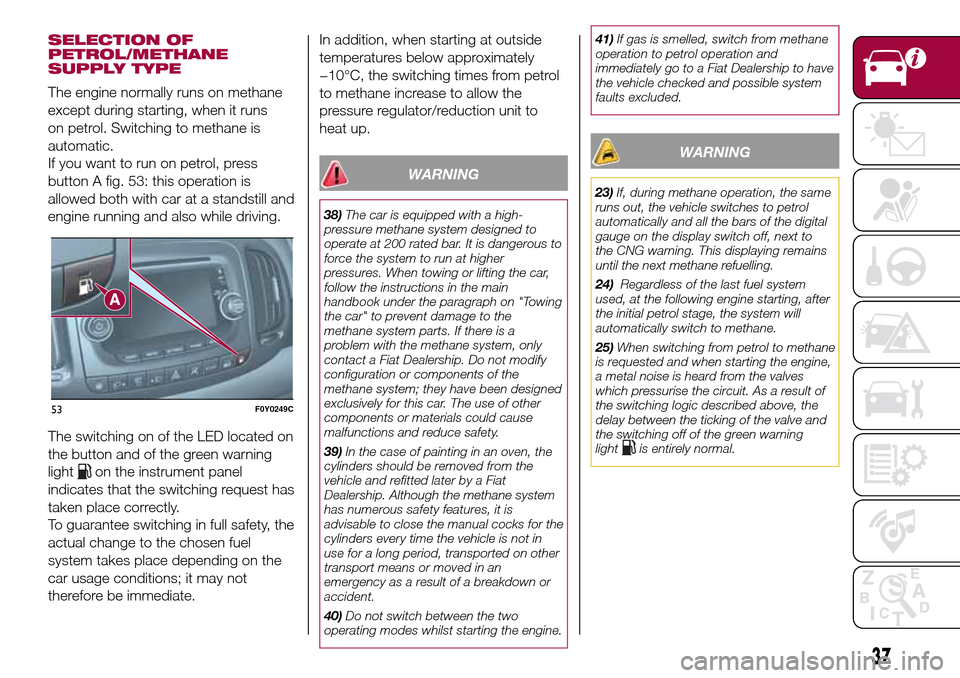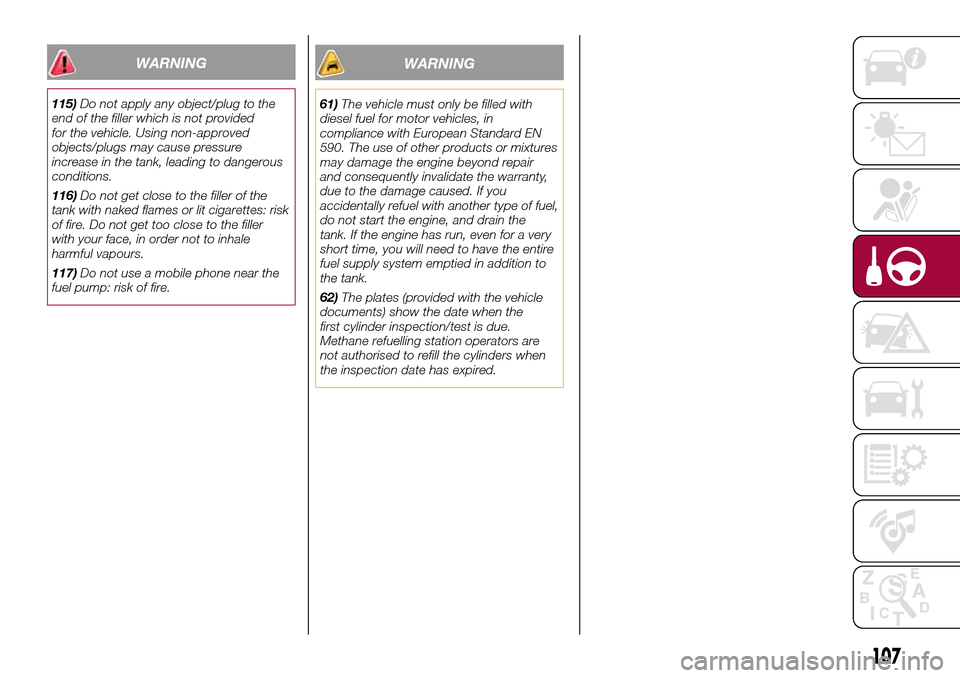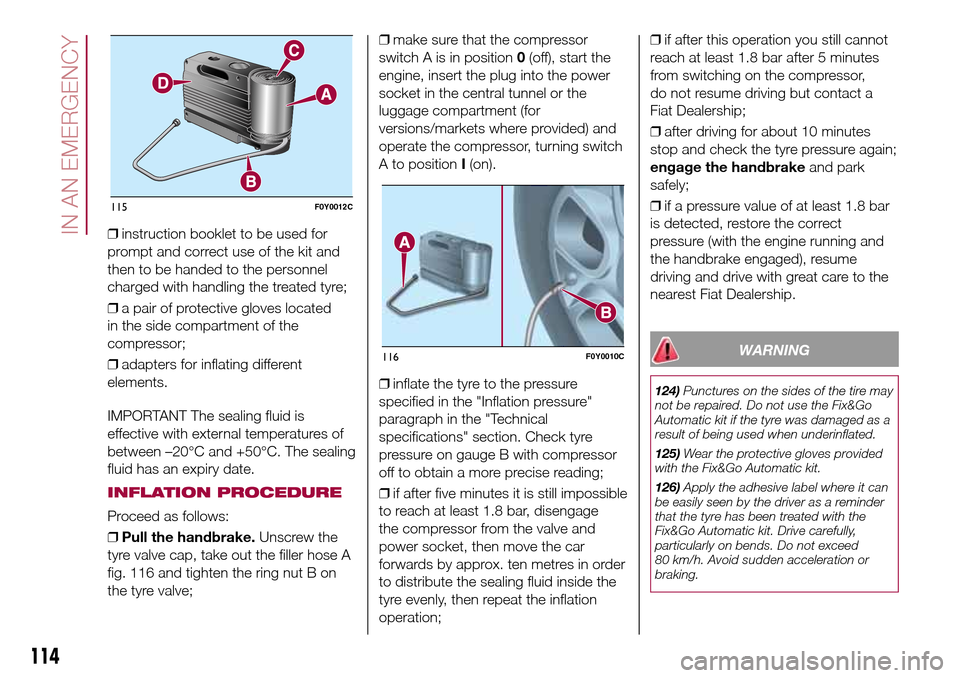Page 39 of 240

SELECTION OF
PETROL/METHANE
SUPPLY TYPE
The engine normally runs on methane
except during starting, when it runs
on petrol. Switching to methane is
automatic.
If you want to run on petrol, press
button A fig. 53: this operation is
allowed both with car at a standstill and
engine running and also while driving.
The switching on of the LED located on
the button and of the green warning
light
on the instrument panel
indicates that the switching request has
taken place correctly.
To guarantee switching in full safety, the
actual change to the chosen fuel
system takes place depending on the
car usage conditions; it may not
therefore be immediate.In addition, when starting at outside
temperatures below approximately
−10°C, the switching times from petrol
to methane increase to allow the
pressure regulator/reduction unit to
heat up.
WARNING
38)The car is equipped with a high-
pressure methane system designed to
operate at 200 rated bar. It is dangerous to
force the system to run at higher
pressures. When towing or lifting the car,
follow the instructions in the main
handbook under the paragraph on "Towing
the car" to prevent damage to the
methane system parts. If there is a
problem with the methane system, only
contact a Fiat Dealership. Do not modify
configuration or components of the
methane system; they have been designed
exclusively for this car. The use of other
components or materials could cause
malfunctions and reduce safety.
39)In the case of painting in an oven, the
cylinders should be removed from the
vehicle and refitted later by a Fiat
Dealership. Although the methane system
has numerous safety features, it is
advisable to close the manual cocks for the
cylinders every time the vehicle is not in
use for a long period, transported on other
transport means or moved in an
emergency as a result of a breakdown or
accident.
40)Do not switch between the two
operating modes whilst starting the engine.41)If gas is smelled, switch from methane
operation to petrol operation and
immediately go to a Fiat Dealership to have
the vehicle checked and possible system
faults excluded.
WARNING
23)If, during methane operation, the same
runs out, the vehicle switches to petrol
automatically and all the bars of the digital
gauge on the display switch off, next to
the CNG warning. This displaying remains
until the next methane refuelling.
24)Regardless of the last fuel system
used, at the following engine starting, after
the initial petrol stage, the system will
automatically switch to methane.
25)When switching from petrol to methane
is requested and when starting the engine,
a metal noise is heard from the valves
which pressurise the circuit. As a result of
the switching logic described above, the
delay between the ticking of the valve and
the switching off of the green warning
light
is entirely normal.
53F0Y0249C
37
Page 109 of 240

WARNING
61)The vehicle must only be filled with
diesel fuel for motor vehicles, in
compliance with European Standard EN
590. The use of other products or mixtures
may damage the engine beyond repair
and consequently invalidate the warranty,
due to the damage caused. If you
accidentally refuel with another type of fuel,
do not start the engine, and drain the
tank. If the engine has run, even for a very
short time, you will need to have the entire
fuel supply system emptied in addition to
the tank.
62)The plates (provided with the vehicle
documents) show the date when the
first cylinder inspection/test is due.
Methane refuelling station operators are
not authorised to refill the cylinders when
the inspection date has expired.
107
WARNING
115)Do not apply any object/plug to the
end of the filler which is not provided
for the vehicle. Using non-approved
objects/plugs may cause pressure
increase in the tank, leading to dangerous
conditions.
116)Do not get close to the filler of the
tank with naked flames or lit cigarettes: risk
of fire. Do not get too close to the filler
with your face, in order not to inhale
harmful vapours.
117)Do not use a mobile phone near the
fuel pump: risk of fire.
Page 116 of 240

❒instruction booklet to be used for
prompt and correct use of the kit and
then to be handed to the personnel
charged with handling the treated tyre;
❒a pair of protective gloves located
in the side compartment of the
compressor;
❒adapters for inflating different
elements.
IMPORTANT The sealing fluid is
effective with external temperatures of
between –20°C and +50°C. The sealing
fluid has an expiry date.
INFLATION PROCEDURE
Proceed as follows:
❒Pull the handbrake.Unscrew the
tyre valve cap, take out the filler hose A
fig. 116 and tighten the ring nut B on
the tyre valve;❒make sure that the compressor
switch A is in position0(off), start the
engine, insert the plug into the power
socket in the central tunnel or the
luggage compartment (for
versions/markets where provided) and
operate the compressor, turning switch
A to positionI(on).
❒inflate the tyre to the pressure
specified in the "Inflation pressure"
paragraph in the "Technical
specifications" section. Check tyre
pressure on gauge B with compressor
off to obtain a more precise reading;
❒if after five minutes it is still impossible
to reach at least 1.8 bar, disengage
the compressor from the valve and
power socket, then move the car
forwards by approx. ten metres in order
to distribute the sealing fluid inside the
tyre evenly, then repeat the inflation
operation;❒if after this operation you still cannot
reach at least 1.8 bar after 5 minutes
from switching on the compressor,
do not resume driving but contact a
Fiat Dealership;
❒after driving for about 10 minutes
stop and check the tyre pressure again;
engage the handbrakeand park
safely;
❒if a pressure value of at least 1.8 bar
is detected, restore the correct
pressure (with the engine running and
the handbrake engaged), resume
driving and drive with great care to the
nearest Fiat Dealership.
WARNING
124)Punctures on the sides of the tire may
not be repaired. Do not use the Fix&Go
Automatic kit if the tyre was damaged as a
result of being used when underinflated.
125)Wear the protective gloves provided
with the Fix&Go Automatic kit.
126)Apply the adhesive label where it can
be easily seen by the driver as a reminder
that the tyre has been treated with the
Fix&Go Automatic kit. Drive carefully,
particularly on bends. Do not exceed
80 km/h. Avoid sudden acceleration or
braking.
115F0Y0012C
116F0Y0010C
114
IN AN EMERGENCY